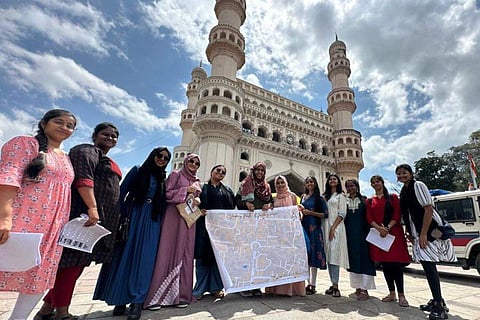
- LIFESTYLE
- FASHION
- FOOD
- ENTERTAINMENT
- EVENTS
- CULTURE
- VIDEOS
- WEB STORIES
- GALLERIES
- GADGETS
- CAR & BIKE
- SOCIETY
- TRAVEL
- NORTH EAST
- INDULGE CONNECT

Visiting local hangouts or tourist places is an experience that is deeply associated with our memories; frequent visits make the experience almost a lived memory, or a memory of the present. However, what encapsulates this memory? Visions, voices, temperature, taste? How often do we remember the olfactory sense experience? Do you remember how those places you know so well, smell at different points in a day?
Exploring our abilities to remember smell and associate places with them, Ar Farah Wahaj organised a heritage walk around Charminar recently. A group of around 40-45 people gathered on a Sunday morning and was briefed by Farah on how to go about the exercise of identifying smells and pinning them down to places. The idea was to finally map these places based on the type of smell most people identify them with. The group was asked to move along a 250m radius in four different directions from Charminar. Each route was marked with five points where the group had to stop and examine the kind of smell they felt was present at that time and jot it down on a questionnaire provided to them along with the intensity of it. Farah also explained briefly what different types of smells can be found in the area, for example, fragrance from flowers or incense, the smell of food being cooked, burnt charcoal, body smells, the smell emanating from open drainage, etc.
The group then got divided into sub-groups and started walking in different directions. They were asked to reconvene in an hour to discuss their findings. We started with a group of young women towards the north. It was more of a whiff of air or the aroma of samosas and ice-creams on carts passing by that caught our attention. At certain points, the fragrance of incense and flowers was strong but mostly it was pollution and smoke. Initially, identifying the distinct smell was difficult unless it was strong enough but gradually, it became easier. A number of new and unique smells were identified including that of burnt iron, hair oil, new clothes and leather bags, etc. After all the groups came back with their findings, Farah asked them to share their experiences and discuss what was relatable among them. “Most people experienced a plethora of overlapping smells and had to delve deep between the layers to actually get what was most vivid. Smells ranged from a temporary whiff of air to food, pollution and smoke,” said Farah.
While mapping down their olfactory experiences, Nimrah on Charminar Road was a unanimous first choice when it came to an appetising smell of fresh baked buttery biscuits that reminded them of past memories, said Farah. “Close up were the smells of kebabs, charcoaled meat and biryani along the Charminar road again. Instincts of shopping indulgence were experienced at its peaks along the Lad Bazaar road which had a smell of new clothes and body spices. Among the hustle of Charminar, participants enjoyed a fresh smelling air along the Rathkhana street that smelt mostly of dental clinics’ phenol smell and fresh lime plaster and brick from the underconstruction GHMC building,” she added.
The walk was organised as part of Farah’s PhD research on associating smells with places and the psychological impact they create on us, specifically on how we create memories and understand heritage through our senses. In a bustling place like Charminar, where each spot presents a uniquely different experience, she admits that narrowing them down to something particular would be difficult, with multiple variables involved. Yet, people coming together to discuss aromatic experiences is a new addition to understanding heritage.